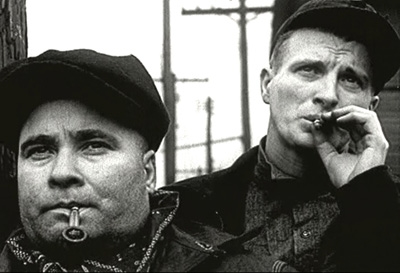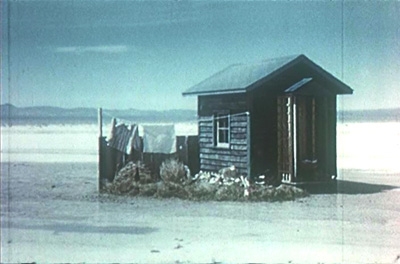

2004, USA, video-projection in loop, DVD, b/w & colour, sound, 90 min.
This film opens with an ordinary couple Don and Claire, who have been hypnotised but don't know it. "You're awake, aren't you?" somebody asks. It's a good question. The film sequences that follow suggest that it's America that's been hypnotised into the banal ordinariness that Don and Claire embody.
Rotterdam Film Festival catalogue
Panorama Ephemera is a collage of sequences drawn from a wide variety of ephemeral (industrial, advertising, educational and amateur) films, touring the conflicted landscapes of twentieth-century America. The films' often-skewed visions construct an American history filled with horror and hope, unreeling in familiar and unexpected ways.
Panorama Ephemera focuses on familiar and mythical activities and images in America (1926-1978). Many creatures and substances that we hardly notice because we feel so used to them take center stage, including pigs, corn, water, telephones, fire, and rice. At first resembling a compilation, it soon reveals itself as a journey through the American landscape over time, and the story begins to emerge between the sequences.
The film consists of 64 self-contained film sequences ranging from 5 seconds to 4 minutes in length arranged into a narrative. Unlike many films made using archival footage, it's primarily a combination of sequences rather than a collage of individual shots.
Panorama Ephemera is populated by American children, animals, farmers, industrial workers, superheroes, pioneers heading West, crash test dummies, and many others.
The Prelinger Archives is a large collection of what I call ephemeral films. These are industrial, advertising, educational, amateur and government films - films that were generally made not to show in movie theatres or on TV, but films that were made to teach, to educate, sometimes to miseducate, to train, to sell, pitch a product, or promote an idea. Films that embody the persuasions of the past. In addition to showing us the way things were, they also show how things were supposed to be. They are a wonderful set of visions of the way we were supposed to think, what we were supposed to buy. A vision of the sort of people we were supposed to become, and as such they record aspects of our history that are suppressed. They are not necessarily public aspects of our history. (...) If we want to have a sense of what it was like to be a member of a family, a nuclear family in the American 50's or 60's, you really can't get that authentically from a TV sit com, or from a Hollywood movie, or from a news reel. But when you see these films, they are filled with footage of idealized families in action. We get a sense of how the family actually looked and behaved, what was the body language, what were the gender roles, how kids were supposed to behave differently than adults, and you also get a sense of that sort of all-encompassing ideology. So you could argue that all of these films, in a way, are sort of an ethnographic vision of a lost America.
Rick Prelinger
